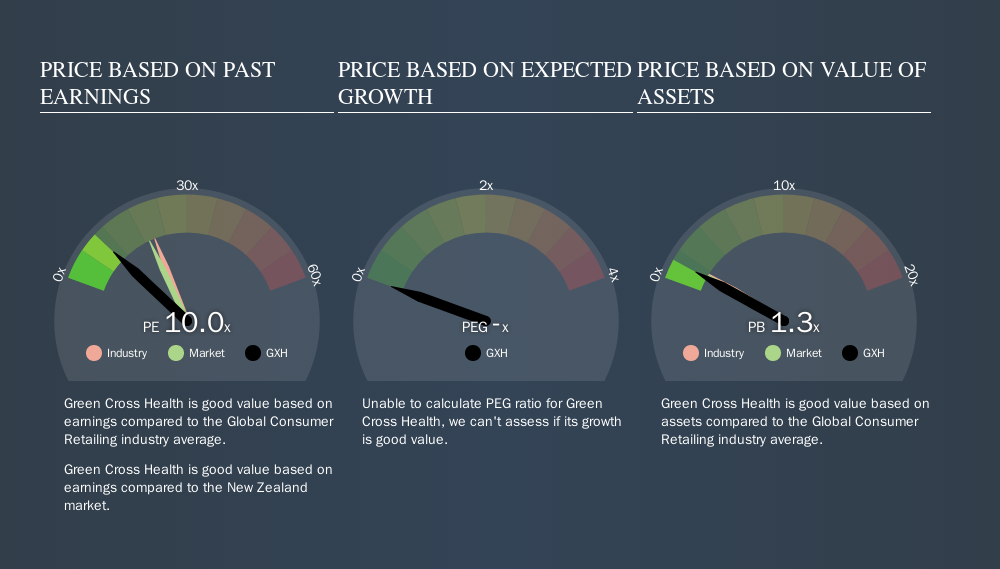- New Zealand
- /
- Food and Staples Retail
- /
- NZSE:GXH
Here's What Green Cross Health Limited's (NZSE:GXH) P/E Ratio Is Telling Us

This article is for investors who would like to improve their understanding of price to earnings ratios (P/E ratios). We'll apply a basic P/E ratio analysis to Green Cross Health Limited's (NZSE:GXH), to help you decide if the stock is worth further research. Based on the last twelve months, Green Cross Health's P/E ratio is 9.96. That corresponds to an earnings yield of approximately 10%.
Check out our latest analysis for Green Cross Health
How Do I Calculate A Price To Earnings Ratio?
The formula for P/E is:
Price to Earnings Ratio = Price per Share ÷ Earnings per Share (EPS)
Or for Green Cross Health:
P/E of 9.96 = NZ$1.12 ÷ NZ$0.11 (Based on the trailing twelve months to March 2019.)
Is A High Price-to-Earnings Ratio Good?
The higher the P/E ratio, the higher the price tag of a business, relative to its trailing earnings. All else being equal, it's better to pay a low price -- but as Warren Buffett said, 'It's far better to buy a wonderful company at a fair price than a fair company at a wonderful price.'
Does Green Cross Health Have A Relatively High Or Low P/E For Its Industry?
The P/E ratio indicates whether the market has higher or lower expectations of a company. If you look at the image below, you can see Green Cross Health has a lower P/E than the average (20.8) in the consumer retailing industry classification.

Green Cross Health's P/E tells us that market participants think it will not fare as well as its peers in the same industry.
How Growth Rates Impact P/E Ratios
Companies that shrink earnings per share quickly will rapidly decrease the 'E' in the equation. That means even if the current P/E is low, it will increase over time if the share price stays flat. A higher P/E should indicate the stock is expensive relative to others -- and that may encourage shareholders to sell.
Green Cross Health maintained roughly steady earnings over the last twelve months. And over the longer term (3 years) earnings per share have decreased 3.6% annually. So it would be surprising to see a high P/E.
Remember: P/E Ratios Don't Consider The Balance Sheet
One drawback of using a P/E ratio is that it considers market capitalization, but not the balance sheet. So it won't reflect the advantage of cash, or disadvantage of debt. Theoretically, a business can improve its earnings (and produce a lower P/E in the future) by investing in growth. That means taking on debt (or spending its cash).
Such spending might be good or bad, overall, but the key point here is that you need to look at debt to understand the P/E ratio in context.
So What Does Green Cross Health's Balance Sheet Tell Us?
Green Cross Health's net debt is 20% of its market cap. It would probably deserve a higher P/E ratio if it was net cash, since it would have more options for growth.
The Verdict On Green Cross Health's P/E Ratio
Green Cross Health has a P/E of 10. That's below the average in the NZ market, which is 19.3. The company does have a little debt, and EPS is moving in the right direction. If growth is sustainable over the long term, then the current P/E ratio may be a sign of good value.
Investors have an opportunity when market expectations about a stock are wrong. If it is underestimating a company, investors can make money by buying and holding the shares until the market corrects itself. We don't have analyst forecasts, but shareholders might want to examine this detailed historical graph of earnings, revenue and cash flow.
You might be able to find a better buy than Green Cross Health. If you want a selection of possible winners, check out this free list of interesting companies that trade on a P/E below 20 (but have proven they can grow earnings).
We aim to bring you long-term focused research analysis driven by fundamental data. Note that our analysis may not factor in the latest price-sensitive company announcements or qualitative material.
If you spot an error that warrants correction, please contact the editor at editorial-team@simplywallst.com. This article by Simply Wall St is general in nature. It does not constitute a recommendation to buy or sell any stock, and does not take account of your objectives, or your financial situation. Simply Wall St has no position in the stocks mentioned. Thank you for reading.
About NZSE:GXH
Green Cross Health
Provides health care and advice services to communities in New Zealand.
Good value with proven track record and pays a dividend.
Market Insights
Community Narratives





